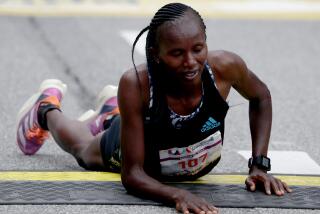GETTING AROUND ‘THE WALL’
- Share via
You’re at mile 20 in the marathon, feeling no pain, striding at a comfortable pace, wind at your back. Suddenly you feel a wave of fatigue so strong it’s as if your body wants to melt into the pavement. Then comes a rush of dizziness -- and disorientation. You’ve hit the wall.
The bane of long-distance runners and endurance athletes, the dreaded wall can derail the best marathon plans. But it’s neither inevitable nor insurmountable.
--
What happens
The feared episode occurs when the body uses up its stockpile of glycogen, a stored form of glucose that’s kept in the liver and muscles. Glycogen is the main fuel used during sustained exercise and largely comes from carbohydrates such as pasta, bread, fruits and vegetables.
When the glycogen stockpile is gone, “the body doesn’t have that fuel source available and must then transfer to another fuel source, which is fat,” says Dr. John DiFiori, chief of the sports medicine division at UCLA. “It can be used as energy, but it’s not as efficient an energy source as glycogen.”
Low blood sugar doesn’t just distress the muscles, says Dr. Robert Sallis, director of sports medicine at Kaiser Permanente Medical Center in Fontana and president of the American College of Sports Medicine. “The brain needs sugar to work as well,” he says, “and actually it’s more sensitive to low sugar than the muscles are.” In a marathon, that depletion can happen at any time -- often around mile 20, sometimes at about two hours. The telltale signs can develop slowly or quickly; many runners describe it as a switch being flipped.
When hitting the wall, runners should slow their pace and immediately take in carbs in the form of sports drinks, gels, energy bars or fruit, says Sallis. He suggests taking in carbs every 45 minutes or so during the race and being aware of any major drop in energy or feelings of wooziness. “For a lot of people who are doing their first marathon, their longest training run has been 20 miles, so the rest is unchartered territory.”
Sallis adds that if runners decide to pass on the carbs and keep going, “most are still able to get through it. It’s not typically something that makes you collapse -- it just slows you way down. Most people still finish.” The body, he says, has enough fat stores (even in thin people) to keep it going. But feeling as if you can’t go on at all, he says, may be a sign of something more serious, such as heat stroke.
It takes just a few minutes for carbs to hit the blood stream, and taking in those carbs via energy gels, carbohydrate-rich sports drinks and energy bars is the best way, Sallis says. “When we’re running, we have all of this blood being shunted away from the gut to the muscles, so there’s not a lot of blood to go to work in the gastrointestinal tract. The simpler the source of carbs, the easier they’ll be to absorb.”
Heat can exacerbate the problem, Sallis adds. “The heart is pumping harder, and you have the body’s cooling systems that are stealing away glycogen to work.” So staying hydrated is important as well.
--
How to avoid it
“People who are better trained are able to use their fuel sources more efficiently,” DiFiori says. “They’re using less energy to perform the work.”
Experienced runners know to load up on carbs before a race, but Sallis warns about piling on too much. “We can only store so much,” he says, “and by eating too many carbs, you can become bloated and sluggish, and that’s no way to start a race.”
Most exercise experts recommend having sensible portions of high-carb foods such as pasta the night before a marathon, then more carbs on the morning of the race. This is the optimum fuel the body will need to perform.
Runners need to take in carbs immediately after the race as well, says DiFiori.
“The first 15 to 30 minutes is important. You’re excited that you’ve finished, but it’s not over yet. You have to begin replacing those depleted fuel stores with a high-carbohydrate beverage or snack,” he says. “You’ve exhausted all those carbs, and you’re going to feel lousy and sluggish. Start with the basics -- energy bars, really digestible stuff, then work your way into more normal foods. It still takes a while for the circulation to go back to the gut.”


